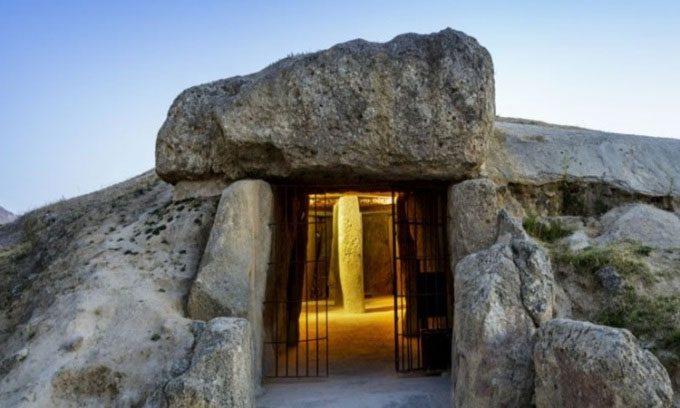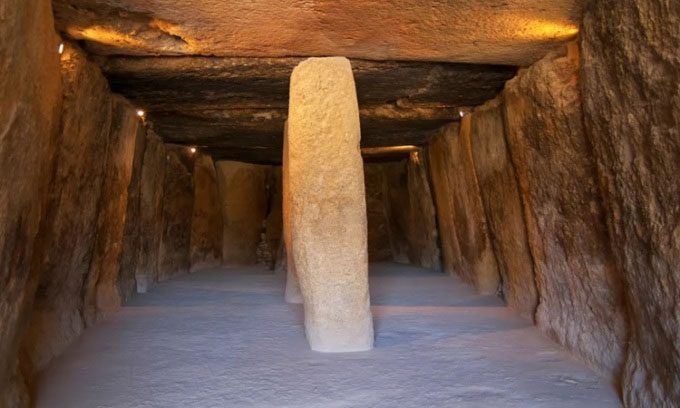Researchers shed light on the construction techniques of a monumental prehistoric stone tomb, revealing a unique example of genius creativity and early science in the Neolithic community.
A massive tomb in southern Spain has been described as the most impressive structure from the Neolithic period following an examination of its colossal features. Known as Menga, the tomb is believed to have been constructed around 5,700 years ago and contains the remains of several hundred ancient individuals.

Menga stone tomb constructed from megalithic stones. (Photo: Cavan).
The discovery, published in the journal Science Advances, reveals that the builders of the Menga tomb in southern Spain possessed advanced technical knowledge that surpasses previous understandings. This finding challenges the traditional view that Neolithic construction techniques were inherently primitive, as reported by Newsweek on August 23. Instead, the study indicates a relatively complex understanding of physics, geology, architecture, and engineering nearly 6,000 years ago.
Located in the province of Antequera in southern Spain, the Menga tomb is one of the largest and most significant megalithic structures from the Neolithic era. It is a prehistoric single-chamber tomb built with large stones known as megaliths.
Constructed around 3600 – 3800 BCE, approximately 1,000 years before the oldest pyramids in Egypt, the Menga tomb consists of 32 large stones forming the roof, walls, and pillars, with a total weight of 1,140 tons. Menga, the oldest of the large stone tombs on the Iberian Peninsula, has long attracted archaeologists and historians due to its massive size and complexity.

Menga tomb built from numerous large stones. (Photo: MariaJose Blazquez).
Weighing about 150 tons, the keystone of Menga is the second-largest stone ever used in a Neolithic tomb. The research team, comprising members from various universities in Spain, describes Menga as the most monumental stone structure of its time in Europe. After analyzing the oversized stones used for the tomb’s construction, scientists found that prehistoric builders chose to work with soft stone, which required exceptional technical skills and logistical planning.
Using a range of petrological and stratigraphic analytical techniques, lead researcher José Antonio Lozano Rodríguez from the University of Alcalá and colleagues found that the Menga stones are primarily calcarenite, a poorly cemented sedimentary rock compared to those used in modern civil engineering. Such rock is particularly difficult to transport without damage, indicating that the builders of Menga had to plan meticulously.
“Working with such large and fragile stone requires significant effort not only in stone shaping but also in handling wood and rope,” the research team stated. “Builders had to use a substantial amount of wood to create scaffolding for the extraction of stones at the quarry and to prepare the transportation route for the large stones.”
Situated on a hilltop, the tomb was carefully oriented to provide three significant advantages in its location. For example, the tomb’s position perfectly aligns with a nearby mountain known as “Lover’s Rock”, and the sunrise creates a complex pattern of light and shadow within the tomb. Additionally, because the structure is slightly lower than the quarry providing raw materials, builders could transport large stones along a downhill route. Finally, the ground beneath the hilltop is much more stable than the soft clay surrounding it, providing a solid and secure foundation for the tomb.
Despite these advantages, the porous nature of the stones used for the tomb’s construction makes them vulnerable to water damage. To address this issue, the designer of Menga separated the largest stones with earthen mounds made from alternating layers of sandstone and compacted earth. After evaluating these innovations, the research team concluded that Menga represents a unique achievement of advanced engineering in prehistoric Iberia and Europe. They published their findings in the journal Scientific Reports.


















































